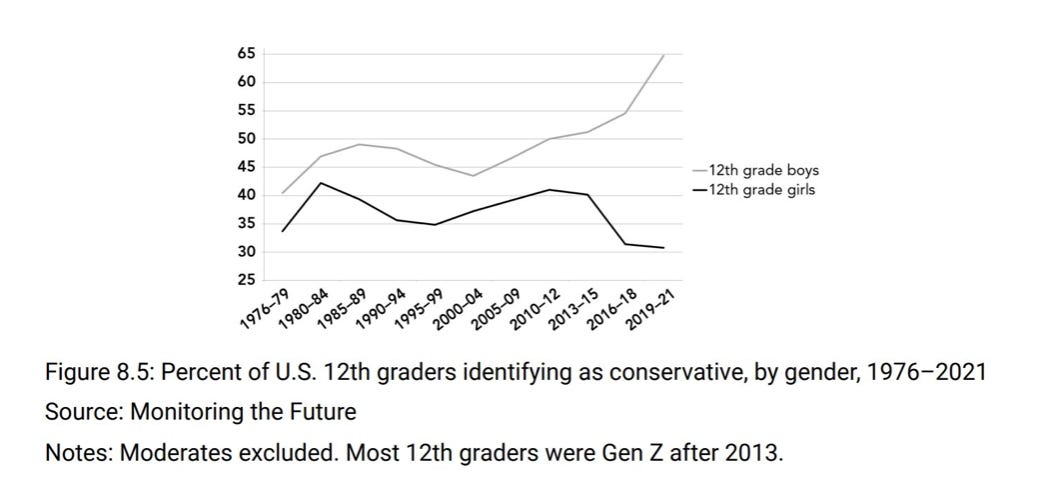The Yawning Youth Gender Gap
Causes and consequences of young men moving rightward while young women move left

As I do on most Fridays, I have a Great Song Suggestion at the end of today’s post. Also per usual, the main part of the post is available in its entirety to all, paying and non-paying subscribers alike, with only the song suggestion concealed behind the paywall. Don’t you want to see what song I recommend, listen to it, and read my comments about it and the artist who wrote it? Life is so deeply enriched by good music—and finding good new music to explore and enjoy is one of its most precious experiences. At least it is for me. If you agree, I hope you’ll consider converting to become a paying subscriber. Of course in doing so you’ll also be supporting my writing at “Notes from the Middleground.” In any event, thanks for being here. Have a good weekend.
The United States is an enormous, dynamic, churning, dizzyingly complex place. Taking in the whole and making useful generalizations about what’s happening—a necessary prior step to saying anything useful about why things are happening the way they are—is incredibly daunting. We need to use the right lens for what we’re trying to see, understand, and describe. We may want to focus on a single object at one point in time. Or we may hope to view its changes down through the years or decades. Or we might be more ambitious, reaching for a wide-angle lens to maximize our depth of field, taking in as much as we can from the scene unfolding before us in the present or recent past.
Today’s post looks briefly at a series of snapshots and then lingers over one of them. The snapshots come from a book I haven’t read but should. The book, written by social psychologist Jean Twenge, apparently contains (among other things) a series of graphs showing generational changes in culture and politics over time in the U.S. These graphs were tweeted out in an extended thread by an account that wasn’t familiar to me prior to encountering the thread online. The account is run by someone clearly on the right. I’m grateful to this person for tweeting out the graphs and making me aware of the book from which they come. I also appreciate that most of the graphs were tweeted out mostly without commentary. That’s the extent of my engagement with the account: Just the graphs.
The graphs tell the story of a country undergoing a fairly dramatic series of generational shifts. Many of them have been noted and discussed before. (Author Jonathan Haidt does more than just about anyone else to make sense of them. He does so in his books and in his Substack newsletter.) But seeing them piled up, one on top of another, makes for a bracing and worrying experience. Something big has happened and is happening—in the United States, and maybe elsewhere as well. Consider this post a very modest contribution to establishing a part of the what. Maybe at some point down the line I (or others) will return to the subject to begin tackling the much more challenging task of answering the why.
Data Points
I urge you to scroll through the thread on your own. But here are some of the highlights.
The frequency of individualistic phrases in American books has surged since the early 1990s.
The percentage of people getting married is cratering.
The percentage of both men and women who have had same-sex experiences is surging from one generation to the next.
Around 2015, people between the ages of 26 and 34 began to experience a surge in major depression.
The amount of time people spend socializing has been trending downward since around 2010, and sharply downward since around 2015.
The share of Gen Zers who consider themselves either transgender or nonbinary is far higher than the share of previous generations.
This trend is taking place pretty equally in both red and blue states.
The share of high-school-aged people who feel lonely or left out has surged since around 2011.
Nearly one third of teenage girls are clinically depressed.
Emergency-room admissions for self-harm are rising.
The share of 12th graders who are pessimistic about the future is also rising.
Each successive generation (from the Silent Generation on through to Gen Z) is more inclined than the last to view the American Founders as “villains,” the country as fundamentally unfair, and to think significant changes are needed to address our problems.
And finally: the graph I want to focus on:
What the Graph is Telling Us—1
Several things can be gleaned from the graph. I’ll start with basic descriptions of what it’s telling us.
First, and most obviously, there’s been a substantial rise in the share of 12th-grade boys self-identifying as conservative over the past two decades (from around 43 percent in the late 1990s to 65 percent in 2021).
Second, 10 percentage points out of this total 22-point increase took place quite recently, between 2016 and 2021—during a period when what it meant to be conservative was largely defined by Donald Trump.
Third, though 12th-grade girls have always been less likely than boys to self-identify as conservative, the two groups began to diverge sharply around 2012. Since then, the share of girls who self-identify as conservative has dropped by about 9 points (from 40 to 31 percent), but the surge for boys has been bigger (up by about 13 points).
Finally, the gender gap in 2021 was larger than ever at 34 percentage points.
What the Graph is Telling Us—2
Now to interpretations.
I first encountered the Twitter thread with the graphs in a Ross Douthat tweet with a bit of sardonic commentary attached to this specific graph: “Not optimal for the propagation of the species.” That prompted me to tweet in reply, “On the other hand, fantastic for porn producers.” I think Douthat and I are both right: A country in which young men and women are increasingly polarized along ideological lines is one in which it will be increasingly difficult for them to find mates with whom to build romantic relationships that culminate in marriage and children. Instead, they will be likely to seek sexual satisfaction in individual acts of self-gratification—or perhaps in relationships with politically compatible members of their own sex.
This could certainly be one factor behind a number of the trends captured in the series of graphs in the tweet thread and in complementary studies: sharply declining marriage rates; an epidemic of loneliness and the mental-health problems that follow from it, including depression and self-harm; experimentation with same-sex relationships; pessimism about the future; and so forth.
Then there are the political implications. According to the most recent data summarized in the graph, around 31 percent of 12th-grade girls describe themselves as conservative while 65 percent of 12th-grade boys do the same. That isn’t a perfect equal-but-opposite balance, but it’s pretty close. If this proves to be enduring as these respondents move into adulthood, it would imply that young men and women over coming election cycles will be close to balancing each other out when it comes to voting patterns, with men strongly favoring the right and women much more likely to support the left.
This runs contrary to a narrative one often hears from Democrats, who often pin a decent share of their political hopes on support from young people. The challenge is to get them to show up to vote on Election Day, with the assumption being that if they do show up, they will strongly favor left-leaning candidates. But with Gen Z men breaking sharply for the right, the net result of the youth vote could soon end up being a wash.
I don’t have much else to say about this graph or the others for now. I just wanted to highlight them with a few notes of commentary. We live at a time of major political and cultural change, both at home and in countries around the world. And we’ve just barely begun to grapple with what it all means. If you want to push a little further in doing exactly that, I can’t recommend highly enough the conversation between my old friend Andrew Sullivan and my even older friend and former teacher Mark Lilla on last week’s Dishcast. There’s more wisdom in their 80-minute discussion than you’ll find just about anywhere these days. I give it my highest recommendation. (If you don’t subscribe to the Weekly Dish and therefore end up locked out of the full conversation, I hope you’ll consider picking up a subscription to get access to the whole thing.)
Great Song Suggestion
Keep reading with a 7-day free trial
Subscribe to Notes from the Middleground to keep reading this post and get 7 days of free access to the full post archives.





